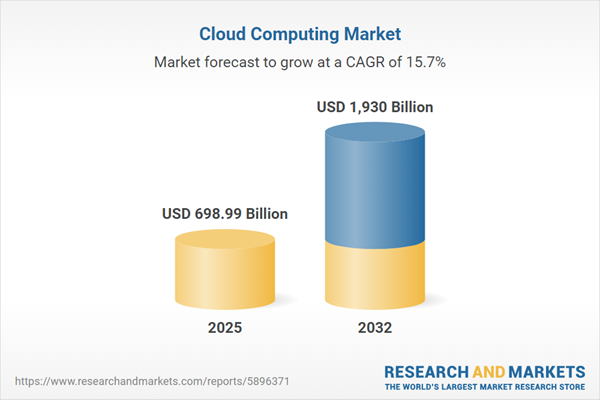Speak directly to the analyst to clarify any post sales queries you may have.
The cloud computing market is experiencing rapid evolution, fueled by rising digital transformation requirements and increasing competitive pressure across industry landscapes. As organizations restructure IT strategies, cloud solutions have emerged as core enablers of agility, resilience, and operational innovation for enterprises worldwide.
Market Snapshot: Cloud Computing Market Size & Growth Trends
The cloud computing market grew from USD 604.16 billion in 2024 to USD 698.99 billion in 2025. It is expected to continue growing at a CAGR of 15.65%, reaching USD 1.93 trillion by 2032. This trajectory demonstrates the market’s expanding influence as organizations migrate from traditional, on-premises infrastructure to cloud-native architectures. Accelerated by enterprise demands for scalable solutions and real-time decision-making, this market offers significant opportunities for vendors and users aligned with transformative technology shifts.
Scope & Segmentation Analysis
- Service Model: Infrastructure as a Service, Platform as a Service (including analytics and application platforms), Software as a Service (such as collaboration, content management, CRM, ERP)
- Deployment Model: Hybrid Cloud (including community and multi-cloud), Private Cloud (hosted private and on-premises), Public Cloud (supported by leading hyperscalers such as AWS, Google Cloud Platform, Microsoft Azure)
- Organization Size: Large Enterprise, Small and Medium Enterprise
- Industry Vertical: Banking Financial Services and Insurance, Government, Healthcare, Information Technology and Telecom, Manufacturing, Retail
- Application: Backup and Recovery, Big Data Analytics, Data Storage and Management, Test Development
- Region: Americas (United States, Canada, Mexico, Latin America), Europe, Middle East & Africa (UK, Germany, UAE, South Africa, etc.), Asia-Pacific (China, India, Japan, Southeast Asia and more)
- Companies Profiled: Amazon Web Services, Microsoft Corporation, Alphabet Inc., Alibaba Group, IBM, Tencent, Oracle, Huawei, Salesforce, VMware
Key Takeaways for Senior Decision-Makers
- Cloud adoption is now foundational for enterprises seeking scalable and resilient digital operations, enabling real-time analytics and enhanced customer experiences.
- Integration of edge computing extends cloud capabilities to remote environments, supporting industries such as manufacturing and transportation with real-time processing.
- Embedding artificial intelligence and machine learning in cloud platforms accelerates predictive insights, automation, and adaptive security, positioning organizations to counter evolving risks.
- Sustainability is increasingly prioritized; providers are rolling out net-zero energy initiatives and advanced data center management to address environmental and cost concerns.
- Multi-cloud and hybrid strategies empower enterprises to balance compliance, cost, and performance by shifting workloads and leveraging multiple vendors for negotiating flexibility.
- Regional market dynamics reflect local compliance, sovereignty, and technology trends, prompting tailored solutions and strategic partnerships to maximize deployment success.
Tariff Impact: Navigating US Policy Shifts
Impending United States tariff policies for 2025 are reshaping the economics of cloud service procurement and supply chain dynamics. Increased duties on hardware and networking equipment will prompt service providers to optimize sourcing strategies and renegotiate supplier contracts, driving potential pricing volatility for enterprise clients. Organizations should track policy developments and adopt multi-vendor procurement to maintain financial oversight amid regulatory uncertainty.
Methodology & Data Sources
This assessment combines in-depth secondary research, primary stakeholder interviews, and quantitative analysis from global technology providers and industry bodies. Trend-extrapolation models, scenario planning, and cross-validation further reinforce analytical rigor, enhanced by third-party peer-review for accuracy and credibility.
Why This Report Matters
- Equips decision-makers with actionable strategies for optimizing cloud investments and managing operational risks in a dynamic environment.
- Provides segmentation and benchmarking to align cloud adoption with organizational objectives and compliance requirements.
- Supports competitive analysis and partner ecosystem development by profiling key industry players across global regions.
Conclusion
The cloud computing market continues to undergo significant transformation, driven by technology advances, regulatory trends, and enterprise priorities. By leveraging the insights presented, stakeholders can build resilient cloud strategies that enable sustainable growth and strategic differentiation.
Additional Product Information:
- Purchase of this report includes 1 year online access with quarterly updates.
- This report can be updated on request. Please contact our Customer Experience team using the Ask a Question widget on our website.
Table of Contents
3. Executive Summary
4. Market Overview
7. Cumulative Impact of Artificial Intelligence 2025
Companies Mentioned
The companies profiled in this Cloud Computing market report include:- Amazon Web Services, Inc.
- Microsoft Corporation
- Alphabet Inc.
- Alibaba Group Holding Limited
- International Business Machines Corporation
- Tencent Holdings Limited
- Oracle Corporation
- Huawei Technologies Co., Ltd.
- Salesforce, Inc.
- VMware, Inc.
Table Information
| Report Attribute | Details |
|---|---|
| No. of Pages | 182 |
| Published | November 2025 |
| Forecast Period | 2025 - 2032 |
| Estimated Market Value ( USD | $ 698.99 Billion |
| Forecasted Market Value ( USD | $ 1930 Billion |
| Compound Annual Growth Rate | 15.6% |
| Regions Covered | Global |
| No. of Companies Mentioned | 11 |









